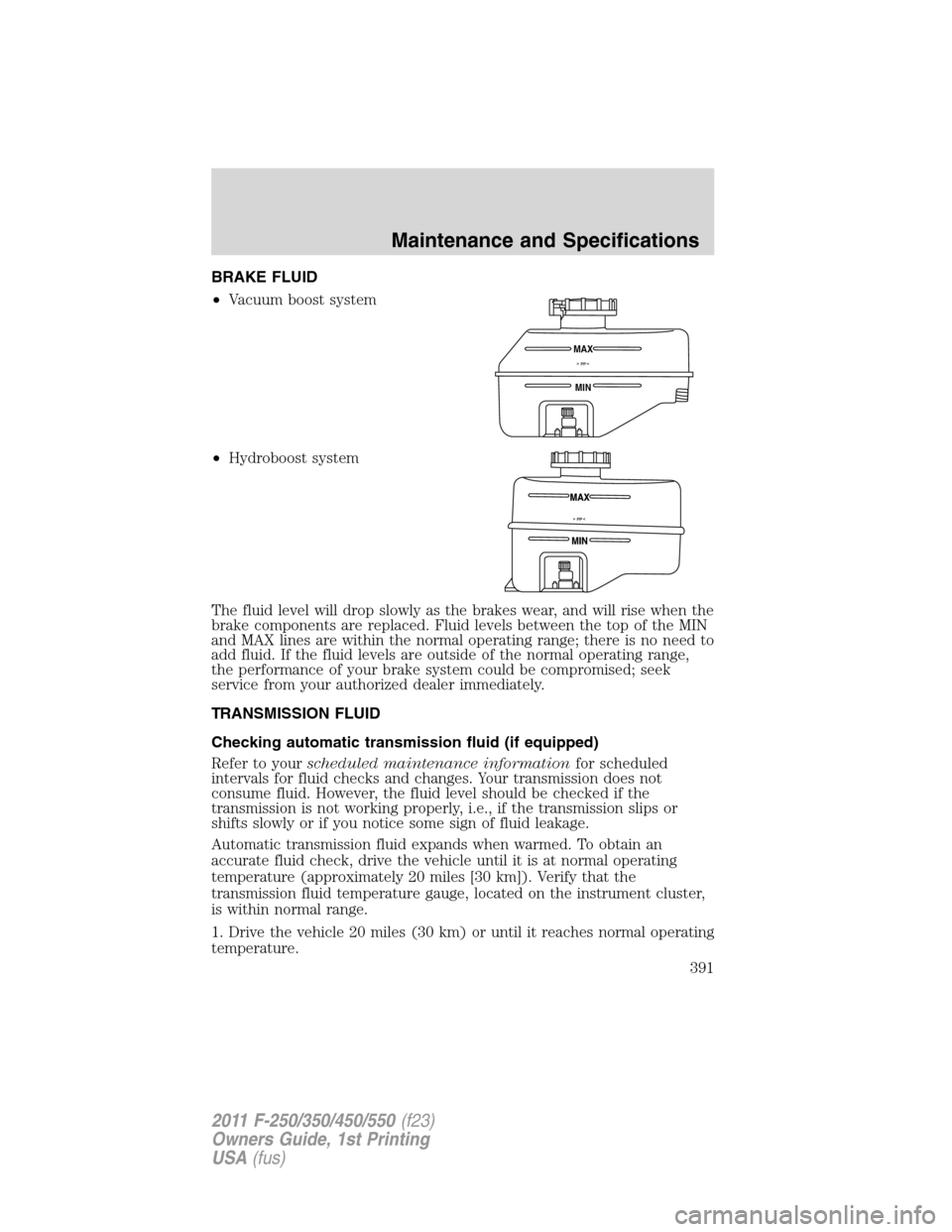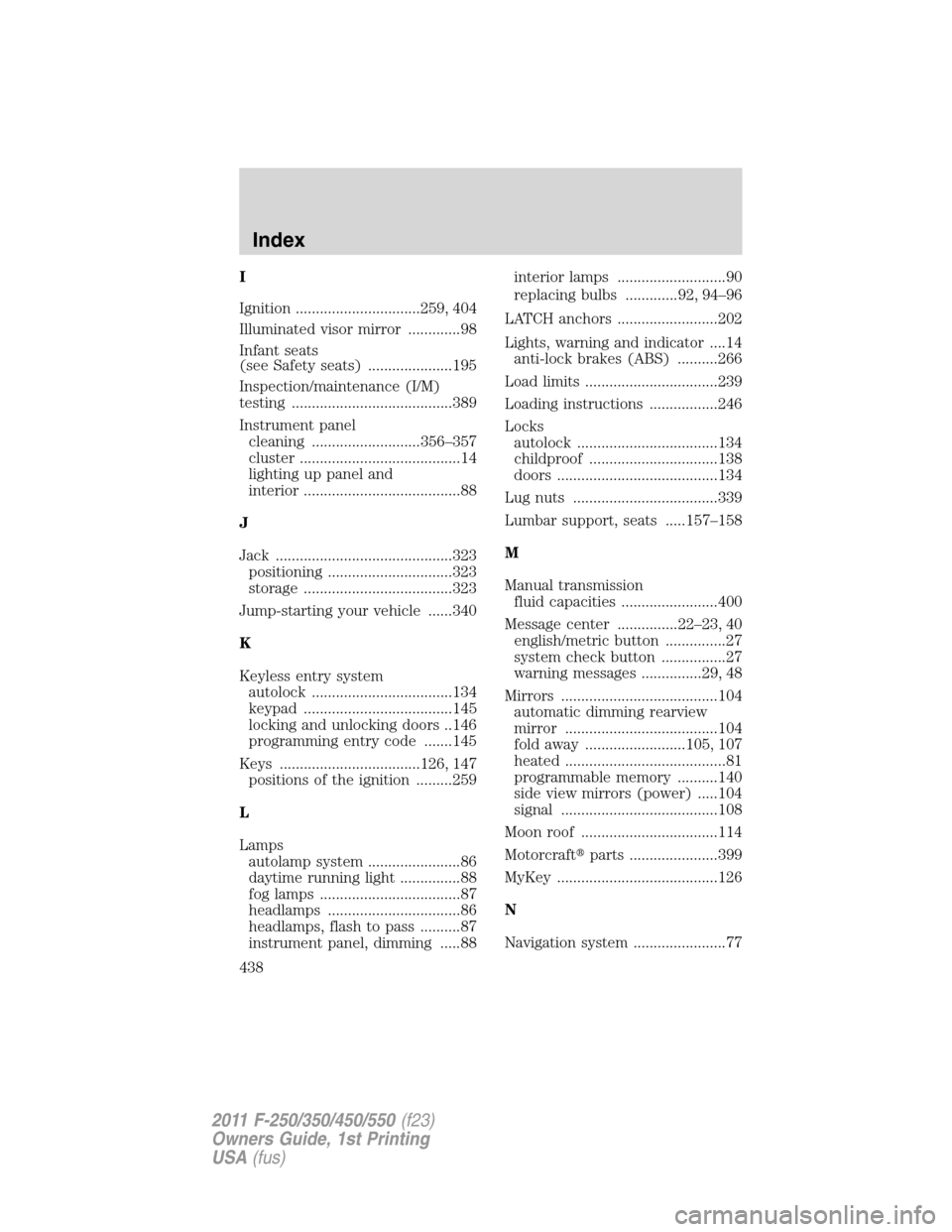Page 356 of 441

helps to remove the hot wax deposited on the wiper blade and
windshield from automated car wash facilities. Be sure to replace
wiper blades when they appear worn or do not function properly.
•Do not use abrasives, as they may cause scratches.
•Do not use fuel, kerosene, or paint thinner to clean any parts.
INSTRUMENT PANEL/INTERIOR TRIM AND CLUSTER LENS
(EXCEPT HARLEY-DAVIDSON)
Clean the instrument panel, interior trim areas and cluster lens with a
clean and damp, white cotton cloth, then with a clean and dry, white
cotton cloth.
•Avoid cleaners or polishes that increase the gloss of the upper portion
of the instrument panel. The dull finish in this area helps protect the
driver from undesirable windshield reflection.
•
Be certain to wash or wipe your hands clean if you have been in contact
with certain products such as insect repellent and suntan lotion in order
to avoid possible damage to the interior painted surfaces.
•Do not use household or glass cleaners as these may damage the
finish of the instrument panel, interior trim and cluster lens.
WARNING:Do not use chemical solvents or strong detergents
when cleaning the steering wheel or instrument panel to avoid
contamination of the airbag system.
If a staining liquid like coffee/juice has been spilled on the instrument
panel or on interior trim surfaces, clean as follows:
1. Wipe up spilled liquid using a clean white cotton cloth.
2. Wipe the surface with a damp, clean, white cotton cloth. For more
thorough cleaning, use a mild soap and water solution. If the spot cannot
be completely cleaned by this method, the area may be cleaned using a
commercially available cleaning product designed for automotive interiors.
3. If necessary, apply more soap and water solution or cleaning product
to a clean, white, cotton cloth and press the cloth onto the soiled
area–allow this to set at room temperature for 30 minutes.
4. Remove the soaked cloth, and if it is not soiled badly, use this cloth to
clean the area by using a rubbing motion for 60 seconds.
5. Following this, wipe area dry with a clean, white, cotton cloth.
Cleaning
356
2011 F-250/350/450/550(f23)
Owners Guide, 1st Printing
USA(fus)
Page 383 of 441

Do not add aftermarket fuel additive products to your fuel tank. It
should not be necessary to add any aftermarket products to your fuel
tank if you continue to use high quality fuel of the recommended octane
rating. These products have not been approved for your engine and
could cause damage to the fuel system. Repairs to correct the effects of
using an aftermarket product in your fuel may not be covered by your
warranty.
Many of the world’s automakers approved the World-Wide Fuel Charter
that recommends gasoline specifications to provide improved
performance and emission control system protection for your vehicle.
Gasolines that meet the World-Wide Fuel Charter should be used when
available. Ask your fuel supplier about gasolines that meet the
World-Wide Fuel Charter.
Diesel engine (if equipped)
Refer to the diesel supplement for information regarding diesel fuel
recommendations and requirements of your diesel-powered truck.
Cleaner air
Ford endorses the use of reformulated “cleaner-burning” gasolines to
improve air quality, per the recommendations in theChoosing the right
fuelsection.
Running out of fuel
Avoid running out of fuel because this situation may have an adverse
effect on powertrain components.
If you have run out of fuel:
•You may need to cycle the ignition from off to on several times after
refueling to allow the fuel system to pump the fuel from the tank to
the engine. On restarting, cranking time will take a few seconds longer
than normal.
•Normally, adding 1 gallon (3.8L) of fuel is enough to restart the
engine. If the vehicle is out of fuel and on a steep grade, more than
1 gallon (3.8L) may be required.
•The service engine soon
indicator may come on. For more
information on the service engine soon
indicator, refer to
Warning lights and chimesin theInstrument Clusterchapter.
Maintenance and Specifications
383
2011 F-250/350/450/550(f23)
Owners Guide, 1st Printing
USA(fus)
Page 391 of 441

BRAKE FLUID
•Vacuum boost system
•Hydroboost system
The fluid level will drop slowly as the brakes wear, and will rise when the
brake components are replaced. Fluid levels between the top of the MIN
and MAX lines are within the normal operating range; there is no need to
add fluid. If the fluid levels are outside of the normal operating range,
the performance of your brake system could be compromised; seek
service from your authorized dealer immediately.
TRANSMISSION FLUID
Checking automatic transmission fluid (if equipped)
Refer to yourscheduled maintenance informationfor scheduled
intervals for fluid checks and changes. Your transmission does not
consume fluid. However, the fluid level should be checked if the
transmission is not working properly, i.e., if the transmission slips or
shifts slowly or if you notice some sign of fluid leakage.
Automatic transmission fluid expands when warmed. To obtain an
accurate fluid check, drive the vehicle until it is at normal operating
temperature (approximately 20 miles [30 km]). Verify that the
transmission fluid temperature gauge, located on the instrument cluster,
is within normal range.
1. Drive the vehicle 20 miles (30 km) or until it reaches normal operating
temperature.
MIN MAX
Maintenance and Specifications
391
2011 F-250/350/450/550(f23)
Owners Guide, 1st Printing
USA(fus)
Page 438 of 441

I
Ignition ...............................259, 404
Illuminated visor mirror .............98
Infant seats
(see Safety seats) .....................195
Inspection/maintenance (I/M)
testing ........................................389
Instrument panel
cleaning ...........................356–357
cluster ........................................14
lighting up panel and
interior .......................................88
J
Jack ............................................323
positioning ...............................323
storage .....................................323
Jump-starting your vehicle ......340
K
Keyless entry system
autolock ...................................134
keypad .....................................145
locking and unlocking doors ..146
programming entry code .......145
Keys ...................................126, 147
positions of the ignition .........259
L
Lamps
autolamp system .......................86
daytime running light ...............88
fog lamps ...................................87
headlamps .................................86
headlamps, flash to pass ..........87
instrument panel, dimming .....88interior lamps ...........................90
replacing bulbs .............92, 94–96
LATCH anchors .........................202
Lights, warning and indicator ....14
anti-lock brakes (ABS) ..........266
Load limits .................................239
Loading instructions .................246
Locks
autolock ...................................134
childproof ................................138
doors ........................................134
Lug nuts ....................................339
Lumbar support, seats .....157–158
M
Manual transmission
fluid capacities ........................400
Message center ...............22–23, 40
english/metric button ...............27
system check button ................27
warning messages ...............29, 48
Mirrors .......................................104
automatic dimming rearview
mirror ......................................104
fold away .........................105, 107
heated ........................................81
programmable memory ..........140
side view mirrors (power) .....104
signal .......................................108
Moon roof ..................................114
Motorcraft�parts ......................399
MyKey ........................................126
N
Navigation system .......................77
Index
438
2011 F-250/350/450/550(f23)
Owners Guide, 1st Printing
USA(fus)